Guolin Ke
Uni-AIMS: AI-Powered Microscopy Image Analysis
May 11, 2025Abstract:This paper presents a systematic solution for the intelligent recognition and automatic analysis of microscopy images. We developed a data engine that generates high-quality annotated datasets through a combination of the collection of diverse microscopy images from experiments, synthetic data generation and a human-in-the-loop annotation process. To address the unique challenges of microscopy images, we propose a segmentation model capable of robustly detecting both small and large objects. The model effectively identifies and separates thousands of closely situated targets, even in cluttered visual environments. Furthermore, our solution supports the precise automatic recognition of image scale bars, an essential feature in quantitative microscopic analysis. Building upon these components, we have constructed a comprehensive intelligent analysis platform and validated its effectiveness and practicality in real-world applications. This study not only advances automatic recognition in microscopy imaging but also ensures scalability and generalizability across multiple application domains, offering a powerful tool for automated microscopic analysis in interdisciplinary research.
Uni-3DAR: Unified 3D Generation and Understanding via Autoregression on Compressed Spatial Tokens
Mar 21, 2025Abstract:Recent advancements in large language models and their multi-modal extensions have demonstrated the effectiveness of unifying generation and understanding through autoregressive next-token prediction. However, despite the critical role of 3D structural generation and understanding (3D GU) in AI for science, these tasks have largely evolved independently, with autoregressive methods remaining underexplored. To bridge this gap, we introduce Uni-3DAR, a unified framework that seamlessly integrates 3D GU tasks via autoregressive prediction. At its core, Uni-3DAR employs a novel hierarchical tokenization that compresses 3D space using an octree, leveraging the inherent sparsity of 3D structures. It then applies an additional tokenization for fine-grained structural details, capturing key attributes such as atom types and precise spatial coordinates in microscopic 3D structures. We further propose two optimizations to enhance efficiency and effectiveness. The first is a two-level subtree compression strategy, which reduces the octree token sequence by up to 8x. The second is a masked next-token prediction mechanism tailored for dynamically varying token positions, significantly boosting model performance. By combining these strategies, Uni-3DAR successfully unifies diverse 3D GU tasks within a single autoregressive framework. Extensive experiments across multiple microscopic 3D GU tasks, including molecules, proteins, polymers, and crystals, validate its effectiveness and versatility. Notably, Uni-3DAR surpasses previous state-of-the-art diffusion models by a substantial margin, achieving up to 256\% relative improvement while delivering inference speeds up to 21.8x faster. The code is publicly available at https://github.com/dptech-corp/Uni-3DAR.
Representation Learning, Large-Scale 3D Molecular Pretraining, Molecular Property
Mar 13, 2025Abstract:Molecular pretrained representations (MPR) has emerged as a powerful approach for addressing the challenge of limited supervised data in applications such as drug discovery and material design. While early MPR methods relied on 1D sequences and 2D graphs, recent advancements have incorporated 3D conformational information to capture rich atomic interactions. However, these prior models treat molecules merely as discrete atom sets, overlooking the space surrounding them. We argue from a physical perspective that only modeling these discrete points is insufficient. We first present a simple yet insightful observation: naively adding randomly sampled virtual points beyond atoms can surprisingly enhance MPR performance. In light of this, we propose a principled framework that incorporates the entire 3D space spanned by molecules. We implement the framework via a novel Transformer-based architecture, dubbed SpaceFormer, with three key components: (1) grid-based space discretization; (2) grid sampling/merging; and (3) efficient 3D positional encoding. Extensive experiments show that SpaceFormer significantly outperforms previous 3D MPR models across various downstream tasks with limited data, validating the benefit of leveraging the additional 3D space beyond atoms in MPR models.
Intelligent System for Automated Molecular Patent Infringement Assessment
Dec 10, 2024



Abstract:Automated drug discovery offers significant potential for accelerating the development of novel therapeutics by substituting labor-intensive human workflows with machine-driven processes. However, a critical bottleneck persists in the inability of current automated frameworks to assess whether newly designed molecules infringe upon existing patents, posing significant legal and financial risks. We introduce PatentFinder, a novel tool-enhanced and multi-agent framework that accurately and comprehensively evaluates small molecules for patent infringement. It incorporates both heuristic and model-based tools tailored for decomposed subtasks, featuring: MarkushParser, which is capable of optical chemical structure recognition of molecular and Markush structures, and MarkushMatcher, which enhances large language models' ability to extract substituent groups from molecules accurately. On our benchmark dataset MolPatent-240, PatentFinder outperforms baseline approaches that rely solely on large language models, demonstrating a 13.8\% increase in F1-score and a 12\% rise in accuracy. Experimental results demonstrate that PatentFinder mitigates label bias to produce balanced predictions and autonomously generates detailed, interpretable patent infringement reports. This work not only addresses a pivotal challenge in automated drug discovery but also demonstrates the potential of decomposing complex scientific tasks into manageable subtasks for specialized, tool-augmented agents.
MolParser: End-to-end Visual Recognition of Molecule Structures in the Wild
Nov 17, 2024



Abstract:In recent decades, chemistry publications and patents have increased rapidly. A significant portion of key information is embedded in molecular structure figures, complicating large-scale literature searches and limiting the application of large language models in fields such as biology, chemistry, and pharmaceuticals. The automatic extraction of precise chemical structures is of critical importance. However, the presence of numerous Markush structures in real-world documents, along with variations in molecular image quality, drawing styles, and noise, significantly limits the performance of existing optical chemical structure recognition (OCSR) methods. We present MolParser, a novel end-to-end OCSR method that efficiently and accurately recognizes chemical structures from real-world documents, including difficult Markush structure. We use a extended SMILES encoding rule to annotate our training dataset. Under this rule, we build MolParser-7M, the largest annotated molecular image dataset to our knowledge. While utilizing a large amount of synthetic data, we employed active learning methods to incorporate substantial in-the-wild data, specifically samples cropped from real patents and scientific literature, into the training process. We trained an end-to-end molecular image captioning model, MolParser, using a curriculum learning approach. MolParser significantly outperforms classical and learning-based methods across most scenarios, with potential for broader downstream applications. The dataset is publicly available.
A high-accuracy multi-model mixing retrosynthetic method
Sep 06, 2024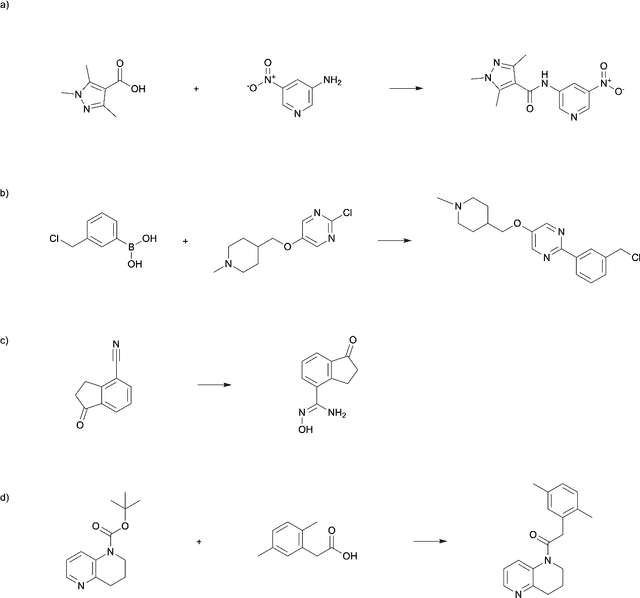

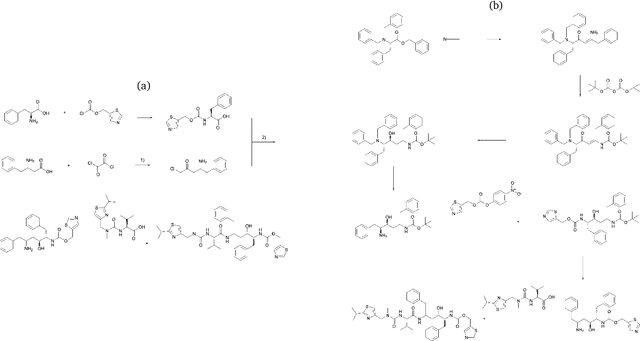

Abstract:The field of computer-aided synthesis planning (CASP) has seen rapid advancements in recent years, achieving significant progress across various algorithmic benchmarks. However, chemists often encounter numerous infeasible reactions when using CASP in practice. This article delves into common errors associated with CASP and introduces a product prediction model aimed at enhancing the accuracy of single-step models. While the product prediction model reduces the number of single-step reactions, it integrates multiple single-step models to maintain the overall reaction count and increase reaction diversity. Based on manual analysis and large-scale testing, the product prediction model, combined with the multi-model ensemble approach, has been proven to offer higher feasibility and greater diversity.
SciLitLLM: How to Adapt LLMs for Scientific Literature Understanding
Aug 30, 2024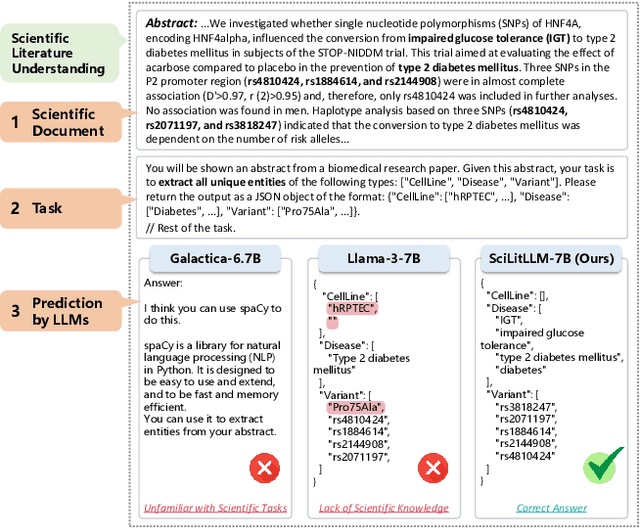
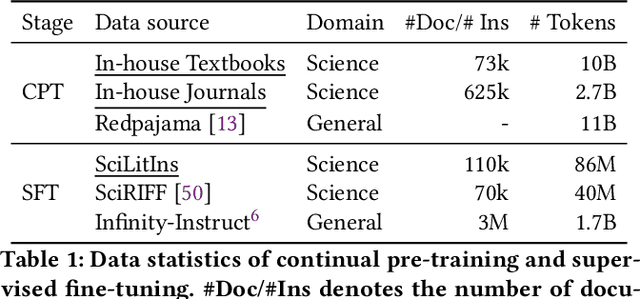
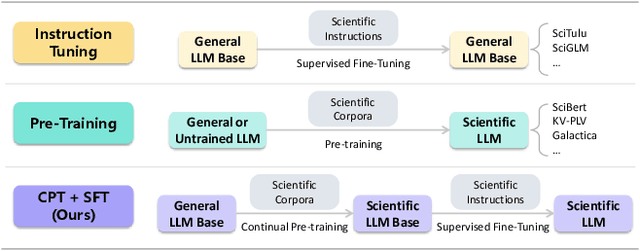
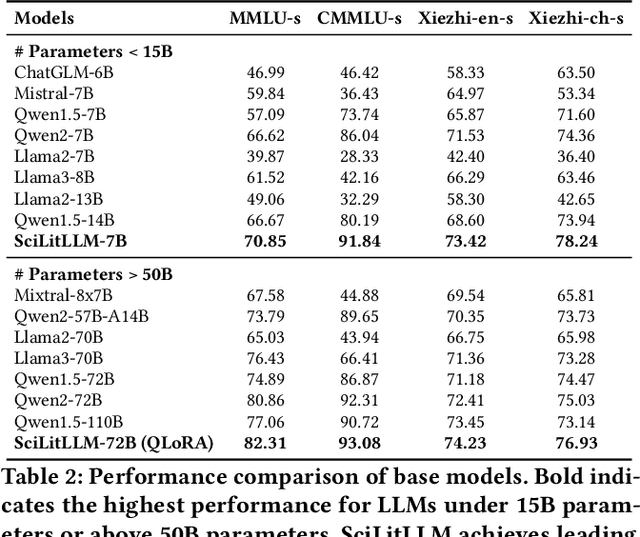
Abstract:Scientific literature understanding is crucial for extracting targeted information and garnering insights, thereby significantly advancing scientific discovery. Despite the remarkable success of Large Language Models (LLMs), they face challenges in scientific literature understanding, primarily due to (1) a lack of scientific knowledge and (2) unfamiliarity with specialized scientific tasks. To develop an LLM specialized in scientific literature understanding, we propose a hybrid strategy that integrates continual pre-training (CPT) and supervised fine-tuning (SFT), to simultaneously infuse scientific domain knowledge and enhance instruction-following capabilities for domain-specific tasks.cIn this process, we identify two key challenges: (1) constructing high-quality CPT corpora, and (2) generating diverse SFT instructions. We address these challenges through a meticulous pipeline, including PDF text extraction, parsing content error correction, quality filtering, and synthetic instruction creation. Applying this strategy, we present a suite of LLMs: SciLitLLM, specialized in scientific literature understanding. These models demonstrate promising performance on scientific literature understanding benchmarks. Our contributions are threefold: (1) We present an effective framework that integrates CPT and SFT to adapt LLMs to scientific literature understanding, which can also be easily adapted to other domains. (2) We propose an LLM-based synthesis method to generate diverse and high-quality scientific instructions, resulting in a new instruction set -- SciLitIns -- for supervised fine-tuning in less-represented scientific domains. (3) SciLitLLM achieves promising performance improvements on scientific literature understanding benchmarks.
Uni-Mol2: Exploring Molecular Pretraining Model at Scale
Jun 21, 2024Abstract:In recent years, pretraining models have made significant advancements in the fields of natural language processing (NLP), computer vision (CV), and life sciences. The significant advancements in NLP and CV are predominantly driven by the expansion of model parameters and data size, a phenomenon now recognized as the scaling laws. However, research exploring scaling law in molecular pretraining models remains unexplored. In this work, we present Uni-Mol2 , an innovative molecular pretraining model that leverages a two-track transformer to effectively integrate features at the atomic level, graph level, and geometry structure level. Along with this, we systematically investigate the scaling law within molecular pretraining models, characterizing the power-law correlations between validation loss and model size, dataset size, and computational resources. Consequently, we successfully scale Uni-Mol2 to 1.1 billion parameters through pretraining on 800 million conformations, making it the largest molecular pretraining model to date. Extensive experiments show consistent improvement in the downstream tasks as the model size grows. The Uni-Mol2 with 1.1B parameters also outperforms existing methods, achieving an average 27% improvement on the QM9 and 14% on COMPAS-1D dataset.
Uni-Mol Docking V2: Towards Realistic and Accurate Binding Pose Prediction
May 20, 2024



Abstract:In recent years, machine learning (ML) methods have emerged as promising alternatives for molecular docking, offering the potential for high accuracy without incurring prohibitive computational costs. However, recent studies have indicated that these ML models may overfit to quantitative metrics while neglecting the physical constraints inherent in the problem. In this work, we present Uni-Mol Docking V2, which demonstrates a remarkable improvement in performance, accurately predicting the binding poses of 77+% of ligands in the PoseBusters benchmark with an RMSD value of less than 2.0 {\AA}, and 75+% passing all quality checks. This represents a significant increase from the 62% achieved by the previous Uni-Mol Docking model. Notably, our Uni-Mol Docking approach generates chemically accurate predictions, circumventing issues such as chirality inversions and steric clashes that have plagued previous ML models. Furthermore, we observe enhanced performance in terms of high-quality predictions (RMSD values of less than 1.0 {\AA} and 1.5 {\AA}) and physical soundness when Uni-Mol Docking is combined with more physics-based methods like Uni-Dock. Our results represent a significant advancement in the application of artificial intelligence for scientific research, adopting a holistic approach to ligand docking that is well-suited for industrial applications in virtual screening and drug design. The code, data and service for Uni-Mol Docking are publicly available for use and further development in https://github.com/dptech-corp/Uni-Mol.
Uni-SMART: Universal Science Multimodal Analysis and Research Transformer
Mar 15, 2024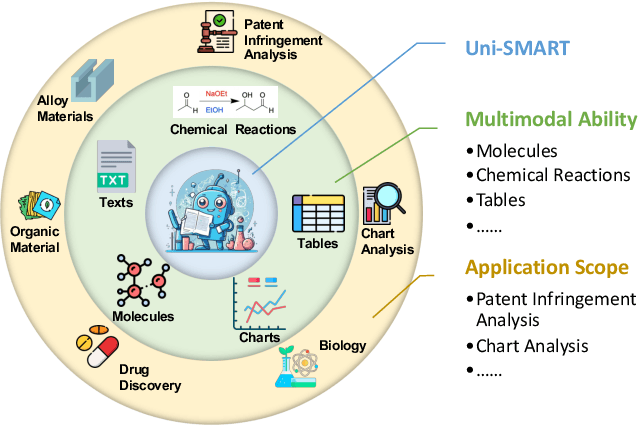
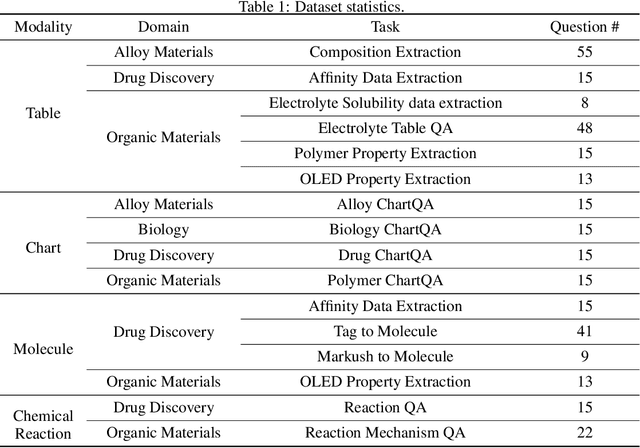
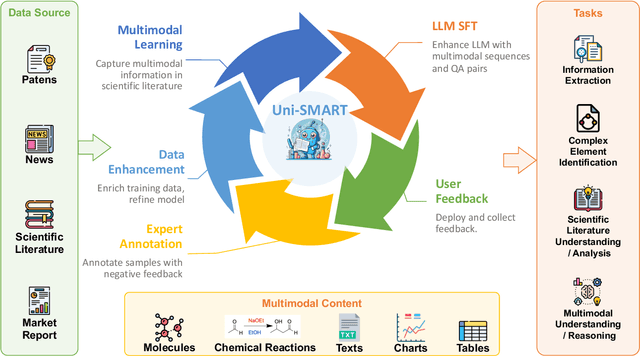
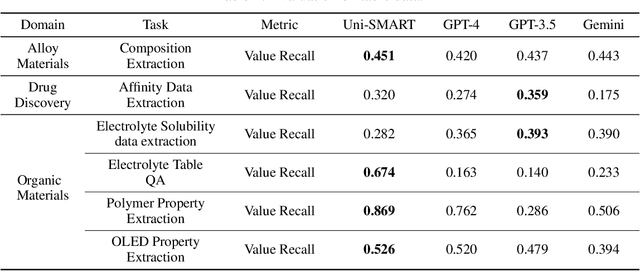
Abstract:In scientific research and its application, scientific literature analysis is crucial as it allows researchers to build on the work of others. However, the fast growth of scientific knowledge has led to a massive increase in scholarly articles, making in-depth literature analysis increasingly challenging and time-consuming. The emergence of Large Language Models (LLMs) has offered a new way to address this challenge. Known for their strong abilities in summarizing texts, LLMs are seen as a potential tool to improve the analysis of scientific literature. However, existing LLMs have their own limits. Scientific literature often includes a wide range of multimodal elements, such as molecular structure, tables, and charts, which are hard for text-focused LLMs to understand and analyze. This issue points to the urgent need for new solutions that can fully understand and analyze multimodal content in scientific literature. To answer this demand, we present Uni-SMART (Universal Science Multimodal Analysis and Research Transformer), an innovative model designed for in-depth understanding of multimodal scientific literature. Through rigorous quantitative evaluation across several domains, Uni-SMART demonstrates superior performance over leading text-focused LLMs. Furthermore, our exploration extends to practical applications, including patent infringement detection and nuanced analysis of charts. These applications not only highlight Uni-SMART's adaptability but also its potential to revolutionize how we interact with scientific literature.
 Add to Chrome
Add to Chrome Add to Firefox
Add to Firefox Add to Edge
Add to Edge